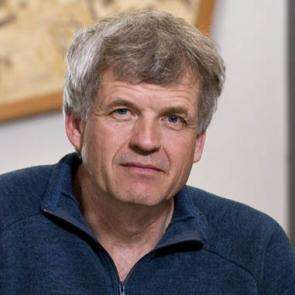Dinosaur site a veritable bone yard, says paleontologist

At this very moment, there could be dinosaur bones beneath your feet. University of Alberta paleontologist Dr. Phil Currie has proof of it - in the form of a dinosaur bone yard in southwest Edmonton.
Originally discovered in the late 1980s by an Edmonton sculptor walking his dog, the site was left largely unexcavated until this summer when Currie and his field school students began unearthing the remains of a duck-billed dinosaur called Edmontosaurus. And now the team has discovered that the site is actually much larger than expected.
"There's no question it's a site with many dinosaurs. So, it's not just one Edmontosaurus skeleton. It is, in fact, many Edmontosaurus skeletons, and then there are tyrannosaurs in there as well," he said. "It's not T-Rex, it's probably Albertosaurus and another animal called Daspletosaurus. These are tyrannosaurs that are smaller than Tyrannosaurus rex but are in the same family."
According to Currie, this is an exciting, but not a surprising, find.
"Edmonton has many dinosaur sites, which many people don't realize," he said. "Basically, what's been found in Drumheller should be found here in Edmonton as well."
Despite being named for the city, the Edmontosaurus had only been previously discovered in southern Alberta, though scientists had reason to think the slow-moving plant eater also resided in the once-swampy habitat of the Edmonton area.
"It is pretty neat that we're finding Edmontosaurus in Edmonton, because the bottom line is that everybody has always assumed that Edmontosaurus comes from the city of Edmonton," he said. "We always knew that Edmontosaurus was probably here, but we never had good specimens before."
Currie added that the site could be as much as 70 metres long, and will take at least a couple of years to excavate.
"It's just impossible to know though, because it might be that after two or three years, that bone plays out. Because unfortunately you can't see under the rocks, like they suggest you can in Jurassic Park."
For now, the team will excavate a small section of about 10 square metres to keep the site safe.
"We're trying to keep it not too big. Of course if you excavate too much of it ... you run risk of damaging bones by exposure to the elements, or vandals, or anything like that," he said, adding that for the same reason, he can't reveal the site's exact location.
"It is always something you have to worry about. It's not that anybody does it deliberately, but sometimes people get curious, or sometimes that want souvenirs, or sometimes they don't even know what they're looking at and they step in things."
However, Currie hopes that interest in the bones will motivate Edmontonians to keep their eyes out for dinosaur bones, which are potentially under threat of being concealed by new homes, or damaged by construction equipment.
"The trouble with some of the better bones in Edmonton, is that they're very nicely preserved bones, but they're black, they're in black sediment. So the rock is black and the bone is black. Unless you look for the differences in texture and shape, you might just miss them," he said. "Fossil bones are hard like all rocks, but of course they break up very easily. And once they're broken, it becomes a problem putting them back together again."
Source: University of Alberta





















